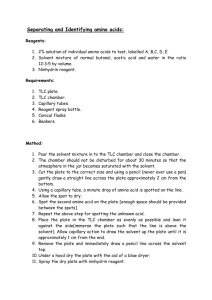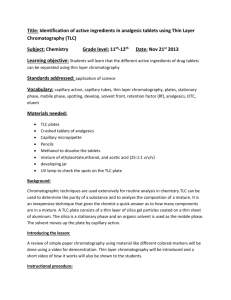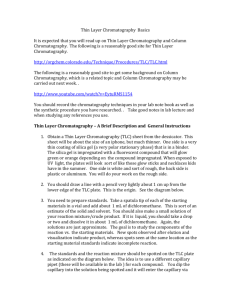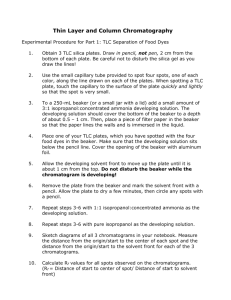THIN LAYER CHROMATOGRAPHY
advertisement
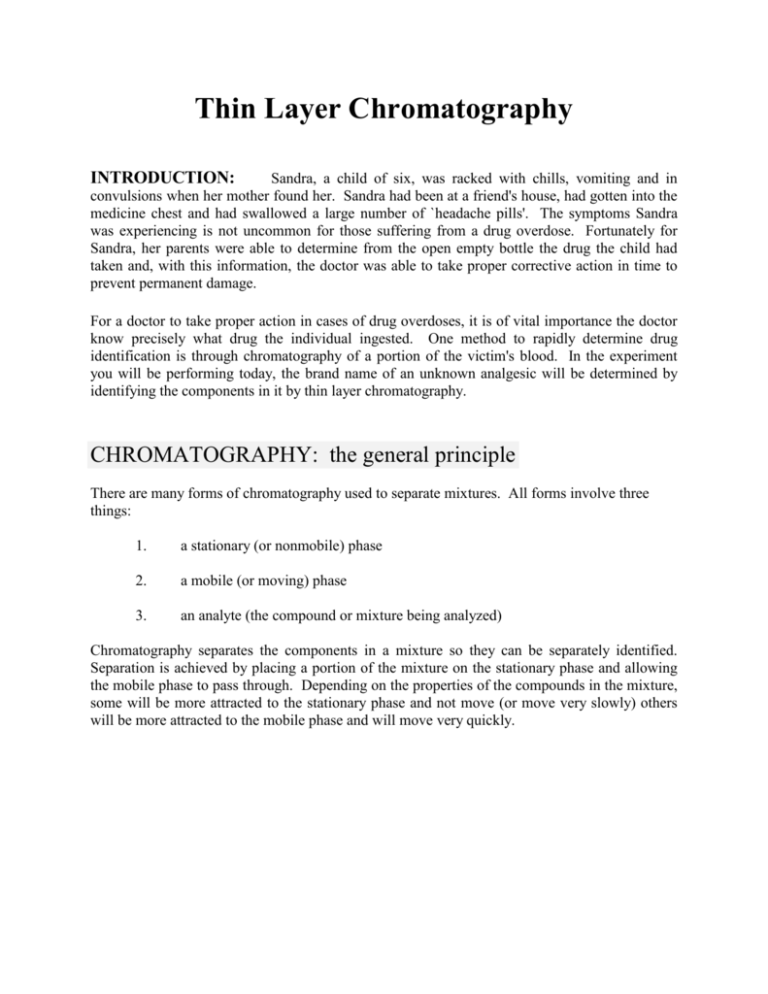
Thin Layer Chromatography INTRODUCTION: Sandra, a child of six, was racked with chills, vomiting and in convulsions when her mother found her. Sandra had been at a friend's house, had gotten into the medicine chest and had swallowed a large number of `headache pills'. The symptoms Sandra was experiencing is not uncommon for those suffering from a drug overdose. Fortunately for Sandra, her parents were able to determine from the open empty bottle the drug the child had taken and, with this information, the doctor was able to take proper corrective action in time to prevent permanent damage. For a doctor to take proper action in cases of drug overdoses, it is of vital importance the doctor know precisely what drug the individual ingested. One method to rapidly determine drug identification is through chromatography of a portion of the victim's blood. In the experiment you will be performing today, the brand name of an unknown analgesic will be determined by identifying the components in it by thin layer chromatography. CHROMATOGRAPHY: the general principle There are many forms of chromatography used to separate mixtures. All forms involve three things: 1. a stationary (or nonmobile) phase 2. a mobile (or moving) phase 3. an analyte (the compound or mixture being analyzed) Chromatography separates the components in a mixture so they can be separately identified. Separation is achieved by placing a portion of the mixture on the stationary phase and allowing the mobile phase to pass through. Depending on the properties of the compounds in the mixture, some will be more attracted to the stationary phase and not move (or move very slowly) others will be more attracted to the mobile phase and will move very quickly. TLC, page 2 of 8 THIN LAYER CHROMATOGRAPHY In thin layer chromatography, or TLC, a small portion of dissolved material is applied as a small dot near the bottom edge of a plastic or glass plate coated with a thin layer of adsorbent. (The adsorbent constitutes the stationary phase). The plate is placed in a closed container containing a small amount of solvent. Capillary action pulls the solvent (the mobile phase) slowly up the plate like water being soaked up by a sponge. The compounds in the sample on the TLC plate (the analyte) can do two things as the solvent moves up the plate: If a compound is attracted to the If a compound is not attracted to the coating it sticks and does not move up coating it will not stick and it does move the plate: up the plate: Actually, most compounds will be partially attracted to both the coating and the solvent. Compounds more attracted to the coating move up the plate slowly, while those more attracted to the solvent travel more quickly and separation is achieved. What features cause some compounds to prefer the stationary phase to the mobile phase? A major factor is polarity of the bonds. The coating is composed of aluminum oxide (Al2O3). The aluminum - oxygen bonds are very polar. The solvent is usually a nonpolar or very moderately polar organic solvent, in this experiment ethyl acetate is used (formula C4H8O2). In general, the more polar bonds a compound has then the more attracted it is to the very polar aluminum oxide and the more slowly it moves up the plate. TLC, page 3 of 8 The structures of the compounds you will be analyzing are shown below. The bonds possessing the important polarity are those bonds between the very electro- negative atom O and C or O and H, and between N and C, or N and H. It is primarily these bonds that determine the overall polarity of these compounds. Remember that it is the difference in electronegativity of the two atoms in the bond that makes a bond polar. With this in mind, carbon-carbon bonds are not polar at all, while carbon-hydrogen bonds are only very slightly polar so both of these types can be ignored. O H3C O N C C N H CH3 H N C C N C H H C C H C C C C C N CH3 C O H ACETAMINOPHEN CAFFEIN H C C H CH3 H C H H O C N C H O H SALICYLAMIDE H H H H C C C C H O C C O O H C O CH3 ACETYLSALICYLIC ACID TLC, page 4 of 8 ANALGESICS The best known and most widely used analgesic is acetylsalicylic acid (known as aspirin). Other commonly used analgesics are those shown previously. Caffeine is not an analgesic, but is sometimes added for its stimulating effects. Caffeine increases the body's sensitivity to carbon dioxide causing an increase in both the rate and depth of respiration. The analgesics given above work to inhibit pain by preventing transmission of pain impulses from the hypothalamus gland (located in the base of the brain) to the cerebral cortex. These analgesics also reduce fever by the following modes of action: 1. causing blood vessels to dilate (enlarge) so more blood can be cooled when it reaches the skin; 2. stimulating diaphoresis (perspiration) so the skin cools blood even more efficiently; 3. by inhibiting the production of certain prostaglandins which normally function to increase body temperature. When viruses or bacteria invade the body, prostaglandins are activated to INCREASE body temperature. Because the invading organisms are more susceptible to high temperatures than your own uninfected cells, this increase in temperature serves as one of the body's methods of ridding itself of invading organisms. Thus, while taking an analgesic drug serves to reduce symptoms associated with infectious disease, it does NOTHING to attack the invading organisms and may, in fact, be counterproductive! Aspirin, and to some extent salicylamide, also exhibit an anti-inflammatory action that is especially useful to people suffering from arthritis. Aspirin is able to reduce swelling and relieve the pain. Some analgesics tablets include other compounds for therapeutic effects such as antihistamines, decongestants and sedatives. In addition to the active ingredients, the tablets must also contain substances such as starch that act as binders to hold the tablets together. TLC, page 5 of 8 EXPERIMENTAL In this experiment you will obtain as an unknown, a well-known analgesic tablet. The object is to identify the drug by comparison with several known compounds. The tablet will be one of those listed below. DRUG INGREDIENTS (BRAND NAME) ANACIN acetylsalicylic acid, caffeine EXCEDRIN acetylsalicylic acid, caffeine, acetaminophen, salicylamide VANQUISH acetylsalicylic acid, caffeine, acetaminophen TYLENOL acetaminophen PROCEDURE Capillaries for applying samples can be made by heating and turning a glass tube until the glass softens and then pulling it in opposite directions. The instructor will demonstrate this for you. Be careful, hot glass looks just like cool glass. Break off six short pieces of the small capillary you just made. Obtain from the stockroom a TLC plate. Don't touch the surface of the plate, or finger prints will appear on the plate. Lay the TLC plate on a page in your note book. With a pencil mark on the page where the corners of the plate are. Also make a mark on the page about 1 cm up from the bottom of the plate. Below the plate make five evenly spaced marks on the page and number them 1-5. Obtain from the stockroom your unknown analgesic in a small test tube. A small amount of solvent will be added, then crush the tablet. Don't worry if it doesn't all dissolve. Using a clean capillary tube for each sample, apply one dot of the following in the order named on the TLC plate (use the lines as a guide): 1. acetaminophen 2. acetylsalicylic acid 4. caffeine 5. salicylamide 3. unknown TLC, page 6 of 8 When all five samples have been applied, place the TLC plate spotted end down in a developing jar and screw on the lid. Don't disturb the jar while the TLC plate is developing or the samples may be ruined. About fifteen minutes are needed for the solvent in the jar to be pulled up the plate. Keep you eye on the TLC plate, and when the solvent is about 1 cm from the top, pull out the plate and quickly mark the solvent line on top of the plate. The solvent will evaporate very easily so don't be slow. Allow the solvent to evaporate in the fume hood. What do you see? Probably nothing. You need to visualize the spots on the plate. This is done in two ways. First, shine an ultraviolet light on the plate and circle any spots you see with a pencil. Record the colors and any other observations you can make about the spots. ANALYSIS OF THE PLATE In TLC, the compounds are compared by their RETENTION FACTORS (or Rf's). These are determined by measuring the distance each sample moved and dividing by the distance the solvent moved. Start at the origin (the place where the sample was applied) and measure the distance to the CENTER of a spot. This is the sample distance. Now measure the distance from the origin to the line where the solvent reached (called the solvent front). This is the solvent distance. Divide the sample distance by the solvent distance, this is the Rf for that spot. Calculate the Rf for each spot on your TLC plate. Using the Rf values for each spot and the observations you made when you visualized the plate, determine which of the known standards are in your unknown analgesic. Using the listed ingredients given above, identify the brand name of the analgesic you analyzed. PRELAB There is no prelab for this experiment. Be sure to write the procedure your notebook! TLC, page 7 of 8 NAME and Drawer #___________________________ Lab Section: Th am Th pm REPORT FOR THIN-LAYER CHROMATOGRAPHY Follow the directions below and answer the questions as directed. Your report will consist of the attached pages. Remove these pages and answer the questions. Turn in your report with the TLC plate stapled to the upper left corner. Reproduce your TLC plate on the outline below. Label the samples with their names. Report the Rf for each. Indicate what was seen for each spot using both visualization techniques. Sample name visualization 1 2 3 4 5 1 2 3 4 5 1. List the ingredients in your unknown: 2. What is the brand name of your unknown? _____________________ Rf TLC, page 8 of 8 3. Rf values have no units, explain why. Show how you calculated the Rf value for each component in your unknown. 4. An aspirin tablet contains 300 mg of aspirin. An arthritic patient requires 0.90 grams of aspirin daily. How many tablets should you give the patient each day? Show unit analysis. 5. A patient requires 1500 mg of sodium bicarbonate (NaHCO3). How many 2.5 grain tablets of sodium bicarbonate should be administered to the patient? ( 60 mg equals 1 grain ) Finally, write a conclusion for this experiment.


